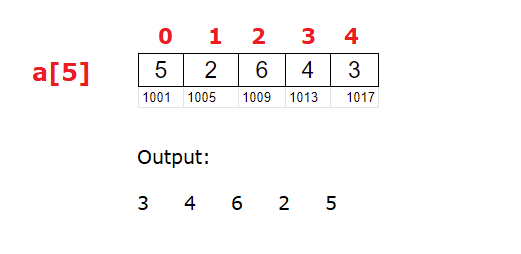Write a c program to display/print elements of an array in reverse order, using pointers.
Pointer Variable: Pointer variable is a variable which holds the address of another variable of same type.
Related Read:
C Program To Print Elements of Array In Reverse Order
Basics of Pointers In C Programming Language
Important Topic
Please watch this important video without fail: C Programming: Arrays, Pointers and Functions
Page Contents
Example: Expected Output
Enter 5 integer numbers
1
2
3
4
5
Elements of array in reverse order …
5
4
3
2
1
Visual Representation

Video Tutorial: C Program To Display Elements of Array In Reverse Order using Pointers
[youtube https://www.youtube.com/watch?v=CYf-rVrKNTI]
Source Code: C Program To Display Elements of Array In Reverse Order using Pointers
#include<stdio.h>
#define N 5
int main()
{
int a[N], i, *ptr;
printf("Enter %d integer numbers\n", N);
for(i = 0; i < N; i++)
scanf("%d", &a[i]);
ptr = &a[N - 1];
printf("\nElements of array in reverse order ...\n");
for(i = 0; i < N; i++)
printf("%d\n", *ptr--);
return 0;
}
Output 1:
Enter 5 integer numbers
1
2
3
4
5
Elements of array in reverse order …
5
4
3
2
1
Output 2:
Enter 5 integer numbers
10
9
8
7
6
Elements of array in reverse order …
6
7
8
9
10
Logic To Display Elements of Array In Reverse Order using Pointers
We ask the user to input N integer numbers and store it inside array variable a[N]. We assign address of (N – 1)th element(last element of any array) to pointer variable ptr.
Inside for loop
We iterate through the for loop and for each iteration we print the value present at the address ptr. And for each iteration we decrement the value of ptr by 1.
This prints the array elements in reverse order.
Important Things To Note
1. Array elements are always stored in contiguous memory location.
2. A pointer when incremented always points to an immediately next location of its own type.
Explanation With Example
int a[5] = {5, 2, 6, 4, 3};
ptr = &a[4];
| i | ptr | *ptr– |
|---|---|---|
| 0 | 1017 | 3 |
| 1 | 1013 | 4 |
| 2 | 1009 | 6 |
| 3 | 1005 | 2 |
| 4 | 1001 | 5 |
Output
3
4
6
2
5
For list of all c programming interviews / viva question and answers visit: C Programming Interview / Viva Q&A List
For full C programming language free video tutorial list visit:C Programming: Beginner To Advance To Expert